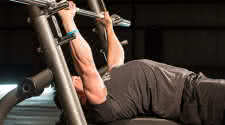Bench Press Angles - The Degree of Angle in Overall Chest Development

Many Different Angles & Techniques for Complete Development
Changing the bench angle alters your body position, stressing the involved muscles in a slightly different fashion.
Over time, doing so incorporates a greater number of muscle fibers and promotes better overall development. Minor
modifications or adjustments to core bodybuilding exercises are a great way to introduce variety into your workouts
without making significant changes to established, mass-building movements.
I often wonder how some bodybuilders respond after repeatedly being told to change their exercise program on a
regular basis, I envision bodybuilders with good potential floundering as they start a new program every few months.
Don't get me wrong change is certainly good - but drastic modifications sometimes do more harm than good. That's
where subtle changes like bench position can make a world of difference.
Let's say you've faithfully included the bench press in your workout for several months but aren't getting the
fullness and definition in your chest that you desire. Instead of deleting the exercise from your program, why not
modify it to target your weak areas, ultimately fulfilling your training goals?
The primary target of the bench press is the pectoralis major (pec) muscle. The standard chest press movement,
performed on a flat bench, is the most direct way to work the entire pec muscle. But because the muscle is so large,
attached to the chest from the clavicle all the way down to the sixth rib, it's difficult to maximally contract the
entire muscle with a single movement in a single plane of motion.
A raised bench slightly shifts the emphasis of the movement from the middle portion of the pecs to the upper region;
development of the upper pecs results in a chest that appeal-s more massive. The incline position also involves the
deltoid (shoulder) muscles to a greater extent and therefore serves as a good exercise for the shoulder-chest tie-in.
Performing the chest press on a decline, with the head of the bench lowered slightly (from the flat position),
causes greater stimulation of the lower pec region, though there's some debate as to the degree. This is where the
belly of the muscles lies, so developing this area leads to a chest that's thicker and has the appearance of greater
separation from the abdomen.
When muscles are forced to contract in a way they aren't accustomed to, muscle fibers are recruited in a somewhat
different manner, and incorporating more muscle fibers increases the potential for growth. Additionally large muscle
groups (chest, back, legs) must be trained from different angles to involve fibers from all parts of the muscle. Just
be careful not to take the adjustable bench positions to extremes, and make sure you start out light to get the hang
of movements at angles you aren't quite familiar with.